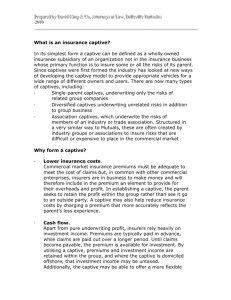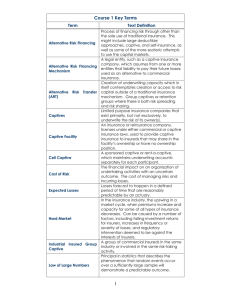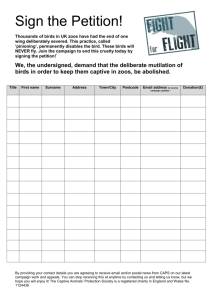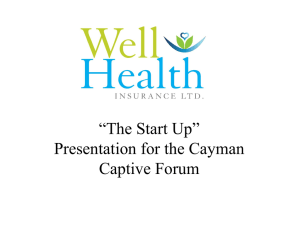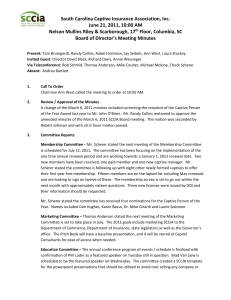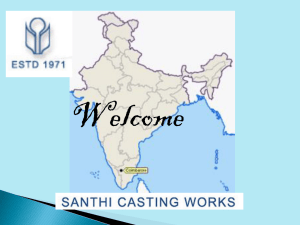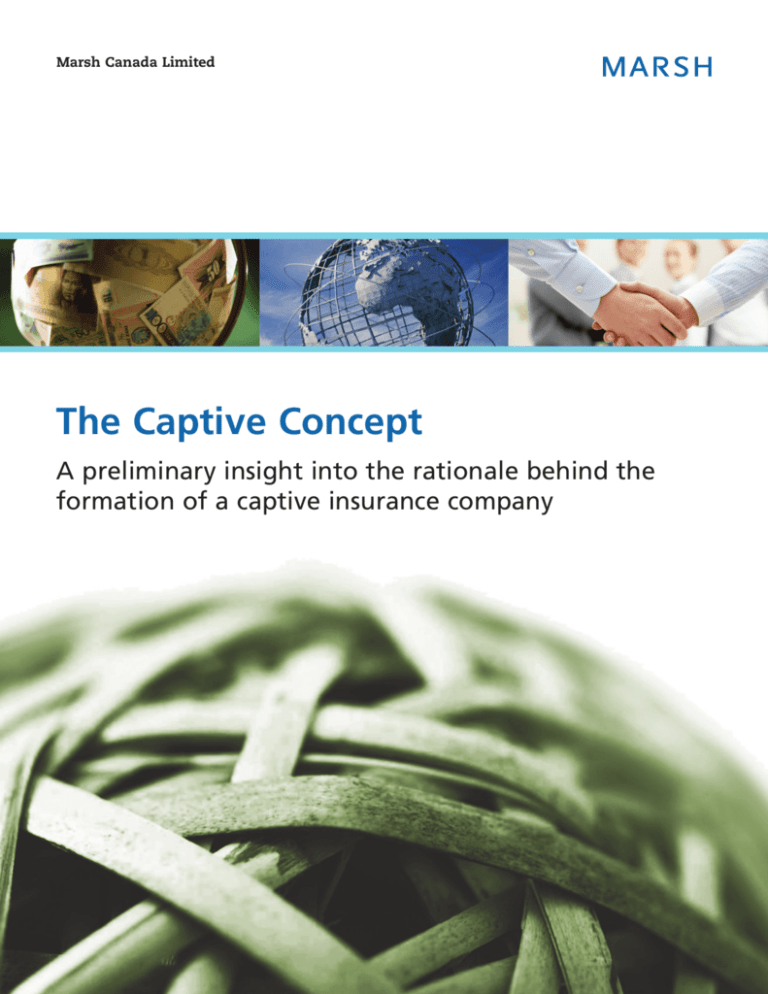
Marsh Canada Limited
The Captive Concept
A preliminary insight into the rationale behind the
formation of a captive insurance company
2 | The Captive Concept
Marsh Canada Limited
What is a Captive?
A captive insurance company is a legal entity formed primarily
to insure the risks of one corporate parent or a number
of similar corporations (e.g. trade associations), thereby
contributing to a reduction in its parent's "total cost of risk".
Captives are usually domiciled in a specialized location, either
offshore or onshore, and sometimes write business unrelated
to their parent. Captives are formed for many reasons,
including the lack of a commercial insurance market for
certain lines of coverage, the desire to recapture underwriting
profits and investment income that would otherwise be
earned by the commercial insurer, as a means to access the
reinsurance market or, in certain circumstances, as a means of
diversifying into insurance services.
Captives are used extensively throughout the world by
major corporations to cover risks situated both at home and
abroad. The largest developments historically have been
in the United States and Europe, but recently considerable
interest has been evident in Canada, the Middle East, the Far
East, particularly from Japan and Australia, as well as South
America. Increasingly, risk finance decision makers are taking
a more global approach to risk financing and captives play an
integral role in the successful implementation of a global risk
financing strategy.
While many captives are established in an "offshore" location,
several European Union countries, Singapore, New Zealand,
and many U.S. states, have captive legislation. Traditionally,
the main reason for having a captive offshore was not, as is
often the perception, the desire to establish in a benevolent
tax environment, but because of regulatory issues and
other business considerations. The recognized "offshore"
domiciles all have statutory regulation drafted with captives
in mind, and the regulatory authorities are used to dealing
with captives. This reduces both the time taken to license a
captive and the regulatory costs incurred by the captive in
comparison with most "onshore" locations. In addition, all
of the established "offshore" domiciles have developed an
infrastructure of support organizations tailored to the needs of
captives, thereby aiding a captive's ability to trade effectively
and economically.
Marsh Canada Limited
The Captive Concept | 3
Captive Insurance Structures
A captive can be a direct
writing company (i.e.
issuing its own policies) or
a reinsurer of a “fronting”
insurance company. The
coverage to be written, the
services required, and the
captive’s domicile usually
dictate the way in which a
captive participates in its
parent corporation’s risk
financing program.
In some countries, local
legislation places restrictions
on the ability of insurance
companies (including
captives), not licensed in
that country, to write
business relating to interests
in that country.
The primary advantages
associated with a direct
writing company are the
elimination of any collateral
requirements for the fronting
company, complete flexibility
in determining the policy
cover, and the manner
in which the program is
structured. However, a direct
writing captive must provide,
or sub-contract, all the claims
handling and loss control
services that are needed
to support the insurance
program. Although, a direct
program can still be more
cost effective than a fronted
program and may provide
a more flexible approach
to program construction,
for example, facilitate the
provision of broader coverage.
4 | The Captive Concept
Location A
Location B
Location C
Captive insurer issues policies,
provides claims handling service,
and retains risk to desired level
Captive
Captive reinsures
in excess of
its desired retention
Reinsurer
Many captives operate as
reinsurance companies.
Location A
Location B
Under
this scenario,
a Location C
locally licensed commercial
insurance company (the
Fronting insurer issues policies
and provides claims
fronting company)
issues
handling service
the policy (or policies) and
is responsible for claims
Fronting Insurer
handling, loss control, and
other insurance-related
Captive insurer issues policies,
provides
claims
handling service,
services.
The
fronting
and retains risk to desired level
company cedes a portion
of the premium and risk
Captive
to the captive through a
reinsurance
contract. The
Captive reinsures
excess of
captive can inthen
retain all
its desired retention
the risk and premium it
assumes or, if appropriate,
Reinsurer
it can pass on (retrocede)
a portion to another
reinsurance company.
Auditors
Marsh Canada Limited
Regulator
Typically, the captive
reinsures the fronting insurer
for the primary layer losses
and the fronting insurer
retains the risk in excess
of the primary layer. Often
Location A
B
Location C
an
aggregateLocation
limitation
is
applied to a captive’s liability
for claims
order
to provide
Captivein
insurer
issues policies,
provides claims handling service,
protection
in risk
the
case
of
and retains
to desired
level
a severe and unforeseen
increase in claims
frequency.
Captive
The aggregate limitation can
be achieved
either
Captive
reinsuresthrough
in excess of
the purchase
of
a “stop loss”
its desired retention
reinsurance or by limiting the
captive’s incoming
Reinsurer maximum
liability in the reinsurance
contract between the fronting
company and the captive.
Location A
Location B
The premium received by the
captive, together with the
investment income earned
on its capital and reserves, is
used to pay losses and loss
adjustment expenses, as well
as various captive operating
expenses, including captive
management expenses,
any local regulatory costs,
legal and audit fees, etc.
The captive must be
adequately capitalized to
ensure its financial viability,
meet with the regulatory
requirements in its domicile,
and demonstrate that
the insurance structure
represents real risk transfer
to the captive.
Location C
Fronting insurer issues policies
and provides claims
handling service
Fronting Insurer
Parent Corporation or
Association
Captive insurer issues policies,
provides claims handling service,
and retains risk to desired level
Captive Board
Captive
Management Company
Captive reinsures
in excess of
its desired retention
Auditors
Regulators
Investment
Managers
Bankers
Reinsurer
Marsh Canada Limited
The Captive Concept | 5
Lawyers
Advantages of a Captive
The major benefits that the establishment of a captive brings
to its parent can be divided into two main categories, financial
and insurance.
Financial Advantages
Reduced Insurance Costs
– Most corporations do
not retain as much risk as
they are able to financially,
and the commercial
insurance market has high
administrative costs which
are passed on to their
clients within the premiums
charged. A captive can
reduce the overall cost of
an insurance program by
retaining the premium for
the expected losses, thereby
avoiding the premium
loading for a commercial
insurer’s overheads and
profits on this element of the
overall premium.
Improved Cash Flow –
Premiums collected and
reserves held for unpaid
claims, otherwise kept by
a commercial insurance
company, can be held by
a captive and invested.
This takes advantage of an
insurer’s ability to establish
such reserves from pre-tax
income that is not possible
for a non-insurance entity.
Matching of Revenue and
Expense – With some types
of coverage, particularly
liabilities to third parties,
losses may emerge over a
number of years. A captive is
6 | The Captive Concept
able to reserve from
current funds for future
claims payments, thereby
matching revenue and
expenses attributable to
each financial year.
Performance Measurement –
A captive is a trading
subsidiary of its parent
for which financial
statements are prepared
and consolidated with its
parent’s. Thus, the financial
impact of the parent
company’s risk management
program can be more easily
monitored and evaluated and
the captive’s performance
measured in terms of return
on investment or other
financial criteria.
Source of Additional Revenue
– A captive can expand its
book of business by offering
insurance to related third
parties, such as franchises,
vendors, or customers,
thereby generating an
additional revenue stream for
its parent. Some captives also
write coverage for unrelated
third parties through
participation in various
reinsurance pools or treaties.
Marsh Canada Limited
Insurance Advantages
Coverage for Risks Not Usually
Insurable
A captive, answerable only
to its parent, can provide
insurance cover that is not
available in the commercial
insurance market or not
available at a realistic
premium.
Reduced Need for Commercial
Insurance
As a captive matures and its
net worth grows, it becomes
capable of retaining a greater
proportion of its parent’s
risks. The increased use of
a captive diminishes the
parent’s dependence on
commercial insurance.
Improved Negotiating Position
As the captive’s ability to
absorb risk grows, it improves
the parent’s negotiating
position with insurance and
reinsurance markets.
Flexibility in Program Design
A captive provides
opportunities to more
easily structure insurance
programs since the captive
is not subject to the same
constraints and conventions
normally evident with
traditional insurers.
Marsh Canada Limited
Broader and Simpler Insurance
Contracts
A captive is usually domiciled
where there is little, if any,
regulation concerning policy
wordings, thereby allowing
specifically tailored insurance
and reinsurance contracts.
Better Risk Management
Program
A captive facilitates:
the design of allocation
systems to distribute
costs more equitably
among profit centres
the implementation
of uniform accounting
procedures
the accumulation of
actuarial information
the design of more
effective claims handling,
loss control, and
engineering programs
the unification of the
application of risk
management throughout
all divisions or
subsidiaries
The Captive Concept | 7
Disadvantages of a Captive
While there are many
potential benefits in forming
a captive, several significant
disadvantages exist which
must be assessed thoroughly
before a decision to establish
a captive is taken.
These are, mainly:
Capital Commitment – The
parent must contribute the
capital required to support
the captive’s business plan,
which must be agreed by the
insurance regulator in the
captive’s chosen domicile.
While these funds remain
within the parent group, they
may not realize the same
return as they would have
if invested in the parent’s
operations.
Operating Cost – In its
formation and operation, a
captive may incur, depending
on the domicile chosen,
various expenses including:
implementation costs
management fee
legal and auditing fee
local taxes
regulatory/licensing fees
In addition, a captive will
require a minor commitment
of the parent company’s
management time and
precipitate some travel costs.
Generally, these costs will
be more than offset by the
financial benefits of the
captive program.
Risk of Adverse Results –
The captive’s capital could
be eroded by adverse
operating results. Although
it is normal to build into any
captive program a degree of
protection against adverse
underwriting results, it is
only possible to minimize
the risk to the captive, never
eliminate it.
It is especially important to
note that if unrelated risks
are written in a captive,
the risk of unprofitable
underwriting results
increases as the captive’s
intimate knowledge of the
parent’s own risks is not
present with unrelated risks.
8 | The Captive Concept
Marsh Canada Limited
Marsh Canada Limited
The Captive Concept | 9
The Road to a Captive
The following is an outline of the complete process of captive
establishment and the assistance that can be provided by
Marsh Captive Solutions:
Phase One
Phase Two
Feasibility
Implementation
Consultation to identify
the parent’s strategic aims
and its tolerance to risk
Preparation of
memorandum and
articles of association
Collection, manipulation,
and analysis of loss data
and exposure
Assistance with the
selection of local
professionals to act as
directors
Preparation of a detailed
feasibility and/or
implementation study to
include:
the captive’s role
optimization of
appropriate retention
levels
its impact on the
insurance program’s
structure
guidance as to the
most appropriate
captive domicile
Appointment of auditors,
bankers, solicitors, etc.
Preparation of an
application to the
authorities for
authorization to trade
Incorporation of the
captive
Provision of a registered
office and compliance
with legal and regulatory
requirements
financial projections
cost/benefit analysis
10 | The Captive Concept
Marsh Canada Limited
Phase Three
Ongoing Management
Insurance services
including:
Corporate services
including:
maintenance of all
records
management reports
underwriting in
accordance with the
directors’ policy
financial statements
and regulatory
reporting
administration
of insurance and
reinsurance program
compliance with the
laws of the captive
domicile
preparation of
all necessary
documentation,
including policies
secretarial support
claims handling and
settlement
Accounting services
including:
payment and receipt
of premiums
claims and recoveries
administration of
operating accounts
cash management
and investments in
accordance with the
captive’s investment
policy
coordination of
board meetings and
provision of facilities
Phase Four
Ongoing Consulting
Advisory services
including:
premium
determination to
ensure market rates
program review
advice on expanded
and new coverages
review of capital
adequacy
advice on captive
corporate governance
polices
benchmaking reviews
Marsh Canada Limited
The Captive Concept | 11
B
Location C
How a Typical Captive
Operates
es policies,
ling service,
esired level
Other than in a rent-a-captive or protected cell arrangement,
a captive is a fully owned, capitalized subsidiary of its parent
company or association. It will be incorporated in a domicile
appropriate to the captive’s role in its parent’s risk financing
program and will be authorized to trade by the regulatory
authorities in that domicile.
ures
of
ention
r
B
Location C
ues policies
laims
vice
Control of the subsidiary will be exercised by a board of
directors appointed by the captive’s shareholders, generally
the parent company. The board usually consists of a mixture
of locally domiciled and parental appointees. The board will, in
turn, appoint selected local organizations to provide support
services to the captive, including, if appropriate, solicitors,
investment managers, auditors, bankers, etc. It is unusual for
captives, particularly newer organizations, to employ their
own staff; a management company is normally appointed.
Parent Corporation or
Association
urer
es policies,
ling service,
esired level
Captive Board
Management Company
ures
of
ention
Auditors
Regulators
Investment
Managers
Bankers
Lawyers
r
The management company carries out all of the operational
functions on behalf of the captive and provides the insurance
and other expertise that is required by the captive. The scope
of the management company’s activities and the extent of its
authority are defined by the board, to whom the management
company reports, in the formal management agreement.
Management reports are prepared by the captive’s manager
and it is usual for the manager to liaise with the appropriate
parental departments, e.g. treasury.
12 | The Captive Concept
Marsh Canada Limited
About Marsh Captive
Solutions Group
Marsh is a leading manager of captive insurance companies
globally managing more than 1,100 single-parent and group
captive programs through its network of captive management
offices in more than 25 captive domiciles worldwide. This
client base consists of organizations from all fields of industry
and commerce in many countries. Marsh has consulting
representations in Canada, the United States, Europe, the Far
East, and Australia, which are available to our clients in the
areas of risk financing, risk management, risk management
information systems, and strategic risk evaluation. The captive
management group has its headquarters in Bermuda.
The Marsh Captive Solutions Group is at the forefront of
developments in risk financing techniques and has some
550 employees dedicated to captive management and risk
financing activities, all of whose knowledge and experience is
available to our clients. Also available indirectly to the Captive
Solutions Group’s clients is the experience and expertise of
Marsh’s global retail and wholesale broking teams.
Marsh employs a team approach to both its captive advisory
and captive management services to bring added value to our
clients through the captive relationship. A team of individuals
representing all of the key skills required to successfully
manage a client’s captive are identified as part of the
implementation process, together with a team leader who
acts as client manager. The client manager acts as a focal
point for the client, through whom all of the resources of
Marsh can be accessed.
Marsh also believes in extending the teamwork concept to its
relationship with its clients, working closely to ensure that a
captive actively contributes to the achievement of its parent’s
strategic goals and assists in establishing benchmarks against
which the performance of a captive can be measured. Marsh
would encourage and assist in the formation of a strategic
plan for a captive that should be reviewed periodically to
ensure that the objectives of the captive remain in line with
its parent’s.
Marsh Canada Limited
The Captive Concept | 13
Marsh Captive Solutions
Contacts
Toronto
Trevor Mapplebeck
Tel: 416 868 2604
E-mail: trevor.mapplebeck@marsh.com
Leadership, Knowledge, Solutions...
Worldwide.
For more information, please contact:
Trevor Mapplebeck
Managing Director
Marsh Canada Limited
Brookfield Place, 161 Bay Street, Suite 1400
Toronto, Ontario M5J 2S4
Telephone: 416 868 2604
Fax: 416 815 3283
E-mail: trevor.mapplebeck@marsh.com
The information contained in this publication provides only a general overview of subjects covered, is not intended to be taken as advice regarding any individual situation, and should not be
relied upon as such. Insureds should consult their insurance and legal advisors regarding specific coverage issues. All insurance coverage is subject to the terms, conditions, and exclusions of the
applicable individual policies. Marsh cannot provide any assurance that insurance can be obtained for any particular client or for any particular risk.
Marsh is part of the family of Marsh & McLennan Companies, including Guy Carpenter, Mercer, and the Oliver Wyman Group (including Lippincott and NERA Economic Consulting).
Copyright © 2008-2011 Marsh Canada Limited. All rights reserved. www.marsh.ca | www.marsh.com
B080305 (C080416TB): 2011/02/08



